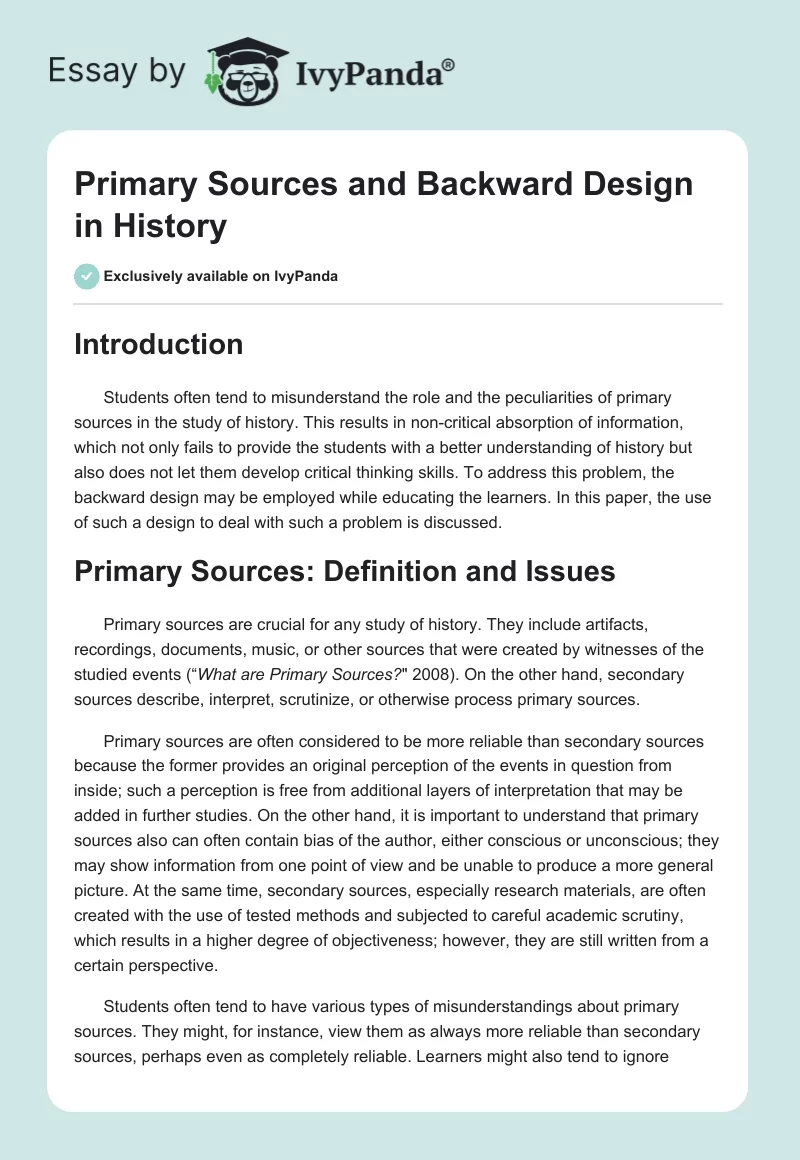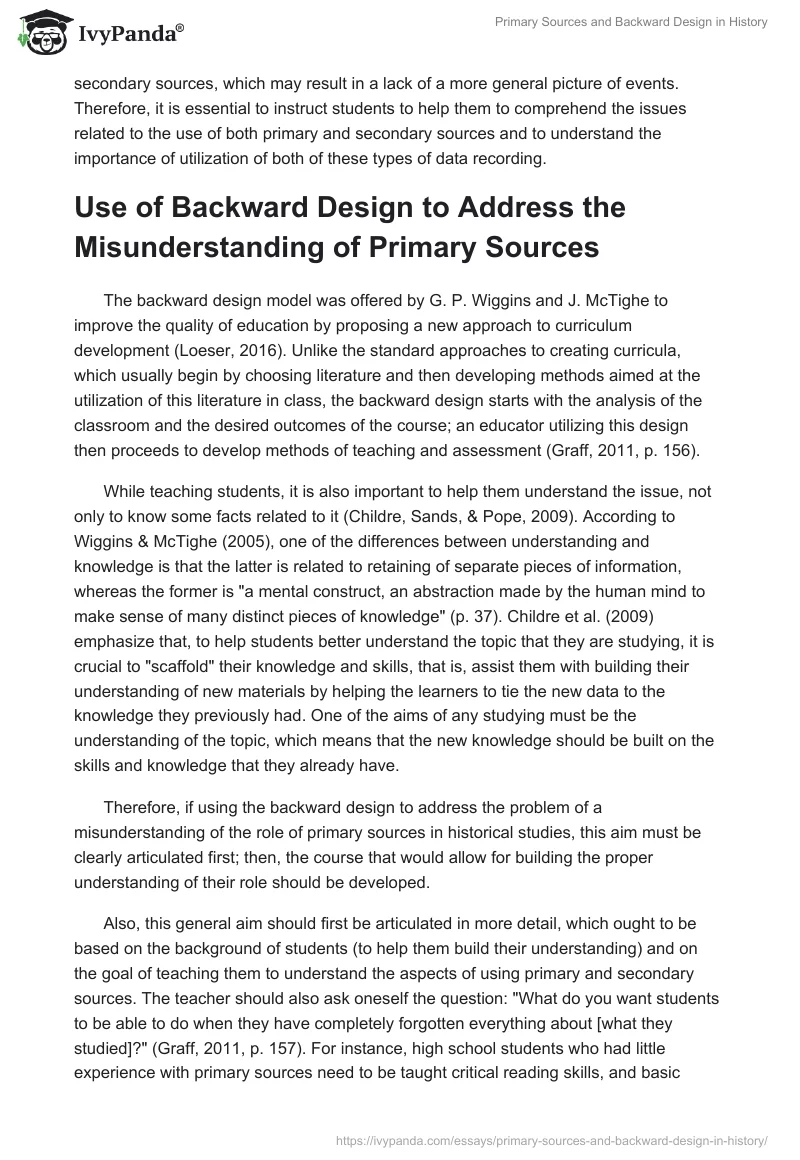Introduction
Students often tend to misunderstand the role and the peculiarities of primary sources in the study of history. This results in non-critical absorption of information, which not only fails to provide the students with a better understanding of history but also does not let them develop critical thinking skills. To address this problem, the backward design may be employed while educating the learners. In this paper, the use of such a design to deal with such a problem is discussed.
Primary Sources: Definition and Issues
Primary sources are crucial for any study of history. They include artifacts, recordings, documents, music, or other sources that were created by witnesses of the studied events (“What are Primary Sources?” 2008). On the other hand, secondary sources describe, interpret, scrutinize, or otherwise process primary sources.
Primary sources are often considered to be more reliable than secondary sources because the former provides an original perception of the events in question from inside; such a perception is free from additional layers of interpretation that may be added in further studies. On the other hand, it is important to understand that primary sources also can often contain bias of the author, either conscious or unconscious; they may show information from one point of view and be unable to produce a more general picture. At the same time, secondary sources, especially research materials, are often created with the use of tested methods and subjected to careful academic scrutiny, which results in a higher degree of objectiveness; however, they are still written from a certain perspective.
Students often tend to have various types of misunderstandings about primary sources. They might, for instance, view them as always more reliable than secondary sources, perhaps even as completely reliable. Learners might also tend to ignore secondary sources, which may result in a lack of a more general picture of events. Therefore, it is essential to instruct students to help them to comprehend the issues related to the use of both primary and secondary sources and to understand the importance of utilization of both of these types of data recording.
Use of Backward Design to Address the Misunderstanding of Primary Sources
The backward design model was offered by G. P. Wiggins and J. McTighe to improve the quality of education by proposing a new approach to curriculum development (Loeser, 2016). Unlike the standard approaches to creating curricula, which usually begin by choosing literature and then developing methods aimed at the utilization of this literature in class, the backward design starts with the analysis of the classroom and the desired outcomes of the course; an educator utilizing this design then proceeds to develop methods of teaching and assessment (Graff, 2011, p. 156).
While teaching students, it is also important to help them understand the issue, not only to know some facts related to it (Childre, Sands, & Pope, 2009). According to Wiggins & McTighe (2005), one of the differences between understanding and knowledge is that the latter is related to retaining of separate pieces of information, whereas the former is “a mental construct, an abstraction made by the human mind to make sense of many distinct pieces of knowledge” (p. 37). Childre et al. (2009) emphasize that, to help students better understand the topic that they are studying, it is crucial to “scaffold” their knowledge and skills, that is, assist them with building their understanding of new materials by helping the learners to tie the new data to the knowledge they previously had. One of the aims of any studying must be the understanding of the topic, which means that the new knowledge should be built on the skills and knowledge that they already have.
Therefore, if using the backward design to address the problem of a misunderstanding of the role of primary sources in historical studies, this aim must be clearly articulated first; then, the course that would allow for building the proper understanding of their role should be developed.
Also, this general aim should first be articulated in more detail, which ought to be based on the background of students (to help them build their understanding) and on the goal of teaching them to understand the aspects of using primary and secondary sources. The teacher should also ask oneself the question: “What do you want students to be able to do when they have completely forgotten everything about [what they studied]?” (Graff, 2011, p. 157). For instance, high school students who had little experience with primary sources need to be taught critical reading skills, and basic information about the period of history. Therefore, the aim would be to promote critical thinking while dealing with sources of information, and not only to teach them history. This might result in choosing materials that would contain completely different views on a problem. On the other hand, history students at their first year of study at university would need to comprehend the nuances related to primary and secondary sources to be prepared to use this knowledge in their professional activity as historians; as a result, when choosing the materials, the focus should be on their being exhaustive, and not only representing a few different points of view.
Possible Ways to Eradicate Obstacles to Future Understanding
To address the obstacles to future understanding of the issues about the use of primary and secondary sources, I would directly articulate this goal before creating a curriculum; I would then adjust my teaching methods to the audience I am teaching. I would start by following the four-step model proposed by Childre et al. (2009). For instance, to educate high school students attending a course in history, I would identify the learners’ background (e.g., learners with no disabilities, or an inclusive classroom), identify curricular priorities (provide an understanding of main trends and events of the studied period, learn to use various types of sources), design assessment framework (to continuously evaluate whether they were able to build new knowledge), and develop learning activities (design the sequence of classes).
For example, a possible and serious obstacle to the deeper understanding of problems related to primary and secondary sources is the absence of explicit practice of using and comparing both types of sources. Therefore, I would not simply explain to the students the issues related to the use of primary sources, but I would strive to provide them with both primary and secondary materials that demonstrate these issues. For instance, in one lesson, the primary materials would contain opposing points of view, whereas the secondary sources would provide a more objective position; in another lesson, I would offer primary materials that only provide a limited view of the problem they are related to, and secondary literature that helps build a general picture, etc.
Conclusion
To sum up, it should be stressed that backward design is an effective tool in education which allows the teachers to instruct their students significantly more effectively. Unlike regular methods, it starts with articulating the goals of instructions; a curriculum is then created that would acquire the defined aims. The backward design can also be employed when addressing the problems related to the utilization of primary and secondary sources; its use is recommended, for cases of misunderstanding about the primary and secondary sources are frequent among students.
References
Childre, A., Sands, J. R., & Pope, S. T. (2009). Backward design: Targeting depth of understanding for all learners. Teaching Exceptional Children, 41(5), 6-14. Web.
Graff, N. (2011). “An effective and agonizing way to learn”: Backwards design and new teachers’ preparation for planning curriculum.Teacher Education Quarterly, 38(3), 151-168. Web.
Loeser, J. (2016). Understanding by design. Understanding by Design – Research Starters Education, 3(1), 1-12. Web.
What are primary sources? (2008). Web.
Wiggins, G. P., & McTighe, J. (2005). Understanding by design (2nd ed.). Alexandria, VA: Association for Supervision and Curriculum Development.


